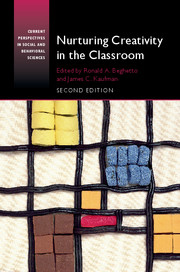Book contents
- Frontmatter
- Dedication
- Contents
- Preface
- Acknowledgments
- PART I VOICES FROM THE FIELD
- 1 Changing the Subject
- 2 Creativity and the Invention Convention
- 3 Creativity and Shifting Roles of an Educational Leader: A Reflection of What Creativity Used to Mean to Me and What It MeansNow
- 4 What I Used to Think about Creativity in Schools
- PART II VOICES FROM THE RESEARCH
- Index
4 - What I Used to Think about Creativity in Schools
from PART I - VOICES FROM THE FIELD
Published online by Cambridge University Press: 24 November 2016
- Frontmatter
- Dedication
- Contents
- Preface
- Acknowledgments
- PART I VOICES FROM THE FIELD
- 1 Changing the Subject
- 2 Creativity and the Invention Convention
- 3 Creativity and Shifting Roles of an Educational Leader: A Reflection of What Creativity Used to Mean to Me and What It MeansNow
- 4 What I Used to Think about Creativity in Schools
- PART II VOICES FROM THE RESEARCH
- Index
Summary
Life can take you on strange and interesting journeys. When I was at an all-boys state school in Australia in the 1960s and 1970s, life seemed predetermined. The smart kids went to a place called university to be smart, and the dumb kids (there were only two types of child at my school) went and did a trade. Knowing now how much it costs to get an electrician or plumber these days, I wonder about this system…
Creativity happened in the Art Department, where a very exotic woman, with long hair and flowing robes, smelling of an exotic substance called patchouli oil, entranced those who were “gifted” with her ability to make pictures or pots out of thin air. As I had no aptitude for pottery or drawing, I accepted that this would always be so. There seemed to be a correlation between art and surfing at my school, or perhaps between art and long hair, I was not certain. My form of expression at school was to be in the school musical. This was not seen as being creative, unless you painted the sets. Learning dialogue and songs was hard, dedicated work, as was learning choreography. I never thought of this as a creative activity, merely a process from learning to performance which was a lot of fun.
Upon leaving school I began to participate in amateur musicals, meeting, for the first time, the “creative types.” These highly idiosyncratic individuals seemed to spend their days as accountants or public servants, only to transform twice a week, in the evening, into what seemed to me to be parodies of the characters we were portraying – flamboyant and exotic, with extravagant hand gestures, and highly affected voices with an indeterminate accent which was part Royal Shakespeare, part working-class Australian with pinched vowels. Creativity seemed to belong in the local halls of Australian suburbia, an outlet from the banality of the workplace, unchanged from the industrial revolution in its conformity to the norm.
- Type
- Chapter
- Information
- Nurturing Creativity in the Classroom , pp. 17 - 20Publisher: Cambridge University PressPrint publication year: 2016

